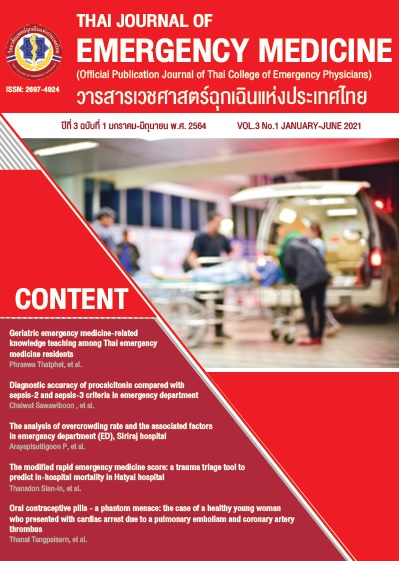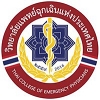The analysis of overcrowding rate and The associated factors in Emergency Department (ED), Siriraj Hospital
Keywords:
ED crowding, Emergency Department, occupancy rateAbstract
Background : Emergency Department (ED) overcrowding has been shown to have an impact on the effectiveness of treatment and could potentially lead to an increased mortality rate. This study aimed to assess the incidence of ED overcrowding and its related factors. A protocol to eliminate such factors and the reduction of unnecessary process could be implemented in the future for the better outcome of ED patients.
Method : A cross-sectional study was conducted at Siriraj Hospital. Adult patients who visited ED during Jan 1,2014 and December 31,2014 were randomly selected. Patients were allocated into two groups, crowding and non-crowding according to the status of ED crowding upon their visit. Baseline characteristics and all treatment process in ED were compared between the two groups. Chi-square test and Mann-Whitney U test was used to analyze the associated factors.
Result : A total of 206 patients were included, 153 patients (74.3%) visited ED in crowding condition. The median waiting time for laboratory result, specialist consultation and admission were 68,15 and 50 minutes, respectively. Median ED length of stay of all patient was 171 minutes, while it was 261 minutes for those who needed hospital admission. There were no statistical significant differences between the two groups. Seven-day mortality was found in 3 (6.4%) and 2 (8.7%) patients of the crowding and non-crowding cohort, respectively.
Conclusion : The rate of ED overcrowding in Siriraj Hospital is 74.3%. There was no statistically significant difference in ED length of stay, mortality rate and waiting time for laboratory results, consultation and admission between patients who visited overcrowding ED and those who visited non-crowding ED.
References
McCarthy ML, Aronsky D, Jones ID. The emergency department occupancy rate: a simple measure of emergency department crowding? Ann Emerg Med 2008;51:15-24.
Seatae S, Chakorn T. Validation of emergency department crowding score in Emergency unit, Siriraj Hospital. In: Seow E, Leong M, Woan LS, Lim SHC, editors. Proceedings of the International Conference on Emergency Medicine 2010 (ICEM 2010); 2010 June 9th-12nd; Singapore. p. 238-9.
Schull MJ, Vermeulen M, Slaughter G, Morrison L, Daly P. Emergency department crowding and thrombolysis delays in acute myocardial infarction. Ann Emerg Med 2004:44:577-85.
Fee C, Weber EJ, Maak CA, Bacchetti P. Effect of emergency department crowding on time to antibiotics in patients admitted with community-acquired pneumonia. Ann Emerg Med 2007;50:501-9.
Richardson D. Increase in patient mortality at 10 days associated with emergency department overcrowding. Med J Aust 2006;184:213-16.
Rondeau KV, Francescutti LH. Emergency department overcrowding: the impact of re-source scarcity on physician job satisfaction. J Healthc Manag 2005;50:327-40.
Kerem Y, Kulstad EB, Mistry CD, Sayger BM, Tekwani KL. Emergency Department crowd-ing is associated with reduced satisfaction scores in patients discharged from the emergency Department. West J Emerg Med 2013;14:11-5.
Lucas R, Farley H, Twanmoh J. Measuring the opportunity loss of time spent boarding admitted patients in the emergency depart-ment: a multihospital analysis. J Healthc Manag 2009;54:117-24.
Asplin BR, Magid DJ, Rhodes KV. A conceptual model of emergency department crowding. Ann Emerg Med 2003;42:173-80
Vermeulen M, Stukel T, Guttmann A, Rowe B, Zwarenstein M, Golden B et al. Eval-uation of an Emergency Department Lean Process Improvement Program to Reduce Length of Stay. Ann Emerg Med 2014;64:427-36.
Chan Hy, Lo S, Lee LLY, Lo Wyu, Yu Wc, Wu YF et al. Lean techniques for the improvement of patients' flow in emergency department. World journal of emergency medicine.2014;5:24-8.
Norgaard B, Mogensen CB. Blood sample tube transporting system versus point of care technology in an emergency department; effect on time from collection to reporting? A randomisled trial. Scand J Truama Re-susc Emerg Med 2012;20:71.
Leong W, Chen L, Yu P, Wei B, Wang C, Ying Yet al. The clinical situation of point-of-care testing and its future development at the emergency department in Shanghai. lab Autom. 2014;19:562-8.
Cheng I, Lee J, Mittmann N, Tyberg J, Ra-magnano S, Kiss A et al. Implementing wait-time reductions under Ontario government benchmarks (Pay-for-Results): a Cluster Randomized Trial of the Effect of a Physi-cian-Nurse Supplementary Triage Assistance team (MDRNSTAT) on emergency depart-ment patient wait times. BMC emergency medicine. 2013;13-7.
Jo S, Jeong T, jin YH! Lee JB, Yoon J. ED crowding is associated with inpatient mortality among critically ill patients admitted via the ED: post hoc analysis from a retrospective study. Am J Emerg Med. 2015;33:1725-31.

Downloads
Published
How to Cite
License
บทความที่ได้รับตีพิมพ์ในวารสารเวชศาสตร์ฉุกเฉินแห่งประเทศไทย ถือเป็นเป็นลิขสิทธิ์ของ วิทยาลัยแพทย์เวชศาสตร์ฉุกเฉินแห่งประเทศไทย
กรณีที่บทความได้รับการตีพิมพ์ในวารสารเวชศาสตร์ฉุกเฉินแห่งประเทศไทยแล้ว จะตีพิมพ์ในรูปแบบอิเล็กทรอนิกส์ ไม่มีสำเนาการพิมพ์ภายหลังหนังสือเผยแพร่เรียบร้อยแล้ว ผู้นิพนธ์ไม่สามารถนำบทความดังกล่าวไปนำเสนอหรือตีพิมพ์ในรูปแบบใดๆ ที่อื่นได้ หากมิได้รับคำอนุญาตจากวารสารเวชศาสตร์ฉุกเฉินแห่งประเทศไทย



